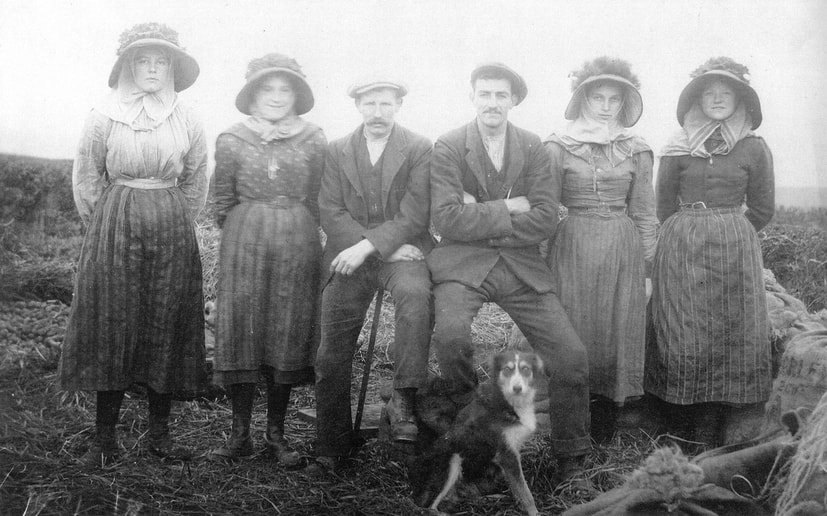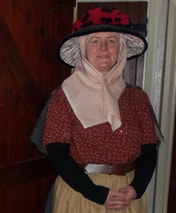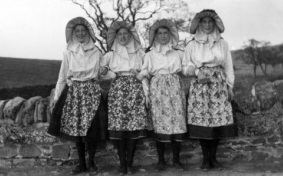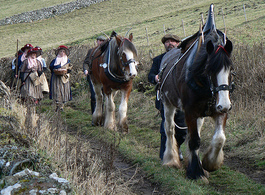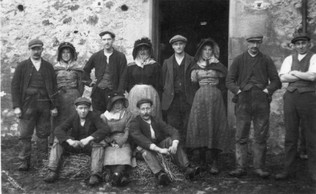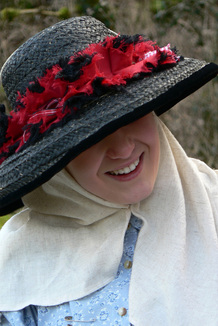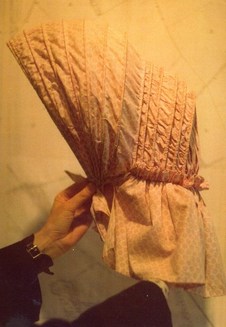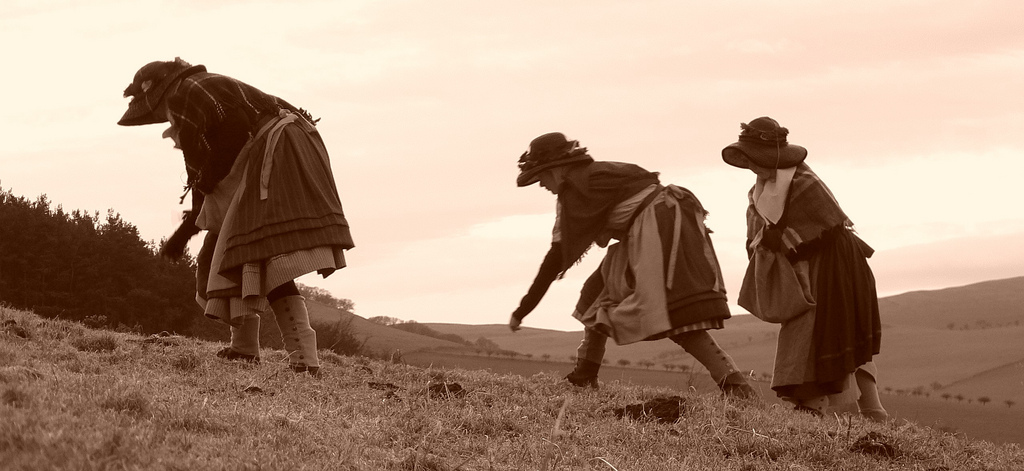|
'1837 was a significant year in the Border area. It was in this year that agricultural workers made a concerted effort to get rid of the bondage system.' They tried again in 1866. They held many public meetings prior to the yearly hiring season which began in February and ran through into March. Despite being very scattered and therefore rather isolated the hinds, bolstered by the meetings, stood together and made objections to the system at each hiring fair throughout the area. These protests were reported in the local newspapers. In 1837 few farmers were ready to listen and only a few successes were reported. One such report was of Mr Tulip, a farmer at Westfield near Cornhill, who was chaired up and down the hiring fair by the delighted hinds once he had hired his men without the bondage condition. As we are off to Who Do You Think you Are Live at Olympia next week showcasing the heritage and highlights of our Border region, Dinah Iredale author of 'The Forgotten Workers' has kindly written this months blog post to accompany our visit. I was absolutely delighted to hear that Susie was keen to take a bondager to the ‘Who Do You Think You Are? Exhibition in London and even more delighted that Susie’s friend Jen had volunteered to dress as the bondager. Luckily I had a complete costume which is a treasured possession since making the film ‘The Forgotten Workers’ with Shadowcat Films in 2012. A trying on session was quickly arranged. Jen looked wonderful in the costume and gave it the thumbs up! Not as drab as she feared it might be! I think she will be a great addition to the exhibition and hopefully will cause quite a stir.
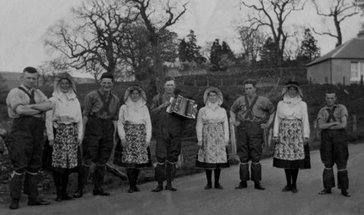 Langshaw's Dancers By Bessie Hermiston Langshaw's Dancers By Bessie Hermiston One other member of the team, Mrs Riddell (nee Easton), talked about the occasion to the Southern Reporter in 2000. In the newspaper article she said that the team must have caused quite a sensation in London with people wondering who they were! “The folk in London must have wondered what was happening when we travelled through the city in an open-topped bus in our bondager costumes. I mind being awful tired when we got back to Lauder.” Bondagers were farmworkers and they played a very important part in the agriculture of Northumberland and South East Scotland. They were employed as fieldworkers under the Bondage System which ensured that the farmers had the number of workers they needed for all the tasks on the farm throughout the year. The hind, a married ploughman, was by his bond or agreement with the farmer compelled to provide another worker. Usually this worker was a woman and because she was part of this bond she was called the bondager. The bondager was often the hind’s wife or daughter and if this was the case her daily earnings helped the family budget. If the hind did not have a family member who could work as the bondager he would need to hire a woman from the hirings and pay her a half year’s wages in advance. He recouped this financial outlay when the farmer paid him a daily rate for the bondager’s work. The hind and his family, as part of his bond, had to find room in their cottage to house the bondager. This was a great imposition on the hind and his family because the cottages were very small. Sometimes the cottages had two rooms or ‘two ends’ as was the local term but more often than not there was one room only. The hind and his family partitioned this space using box-beds to give a little privacy but housing a stranger with their family was difficult. There were many grumbles about bondagers telling tales, gossiping or being lazy and unwilling to help the hind’s wife with household tasks. The hinds hired the bondagers as their ‘servants’ and strictly speaking they should have worked at anything they were asked to do by the hinds and their wives but a common comment was that the ‘bondagers were not fond of household work’ and Munby in his diaries commented that the bondager might ‘lounge about like a lad and whistle and snooze, until she be ordered afield’. 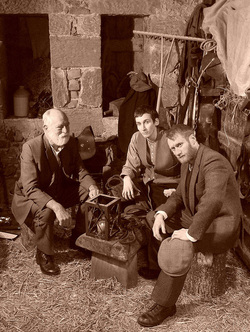 The Forgotten Workers by R. Risborough The Forgotten Workers by R. Risborough In 1866 things were quite different and the farmers were becoming more sympathetic. There were a number of reasons for this change of attitude but one important change was mechanisation. This was definitely beginning to make a difference and the pressure at harvest-time for a very large workforce was not so great. Farmers were also increasingly aware that they were losing their young skilled workers. Young hinds were particularly affected by the Bondage System because they often had a number of small children who couldn’t work and a wife fully occupied with caring for the children. In this situation the hinds had no option but to hire their bondagers from the hirings and house them with their families. Many young hinds were deciding to leave the land and finding work elsewhere. Despite these improvements any farmer who could not readily get extra workers from a nearby town made no secret that they would look for ‘good families’ at the hirings! By this they meant families with a number of members who were able to work – the dad as the hind, a son as the ‘odd laddie’ and one or two daughters as bondagers. The Bondage System did eventually disappear but this was gradually over many, many years with women still being employed as part of the hind’s contract at the beginning of the 20th century. 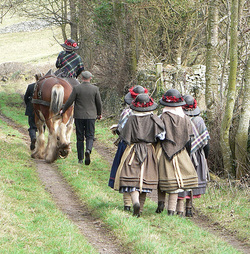 The Forgotten Workers by Adam Fletcher The Forgotten Workers by Adam Fletcher The term bondager was still used for women farmworkers even after the Bondage System had disappeared and the distinctive costume was worn by the women workers right up till the Second World War. The costume was very colourful and distinctive and was worn very much as a uniform for work. The women were well aware of fashion and wore fashionable clothes on Sunday. A large shady hat was a particular feature of the costume and there were two very different styles. One of these hats was made of black straw and highly decorated with ruching round the crown. The ruching was trimmed with buttons, beads, flowers, feathers and plaited straw favours. Another hat, latterly worn in East Lothian, was a large cotton bonnet called an ugly which was supported by cane to give it its unique shape. Under the hat the bondagers wore a wimple or ‘heid hankie’. This cloth head covering together with the hat, shaded the workers from the sun. The bondagers wore a sprigged or striped cotton blouse and a shawl with stripy skirt known as a petticoat. The petticoat was quite short and just covered the knee. Over this was worn various aprons depending on the work in progress. For the very dirtiest work they wore a hessian apron known as a ‘brat’ or ‘brattie’. The bondagers’ work involved a lot of lifting and they liked to wear stays because they felt this strengthened their back. They also liked a good leather belt for the same reason. Black hand-knitted stockings, divided drawers, leggings and tackety boots completed the outfit. This costume was very distinctive and attractive and the bondagers were a great feature of the landscape in this northern area. They could be seen working in large groups of ten or more busily singling turnips, making hay, stooking corn, picking potatoes or spreading muck. Beatrix Potter wrote about their ‘black straw mushroom hats’, in her journal, when staying at Lennel near Coldstream. William Cobbett also noticed them when riding through the Border area and thought they looked like ‘romantic milkmaids’ Cuthbert Bede included them in his novel ‘The Adventures of Mr. Verdant Green’ and described them as ‘great strapping damsels of three or four woman power’! Clips of the 'The Forgotten Workers' by Shadowcat Films. For more information on The Bondagers story or to purchase the DVD or book by Dinah Iredale, follow this link http://thebondagers.com/the-bondagers-home
Wish us luck at Who Do You Think You Are Live. It promises to be a great show, and we are all looking forward to meeting lots of you there. The free 'Prize Draw' to win a luxury hamper or five hours free research is open until the 31 March 2014. All you need to do is sign up for our 'Top Tips' by email service. A must for any family history enthusiast!
3 Comments
Odette Venuti
18/2/2014 10:49:37 pm
Well, you've done it again. I'm trying to picture some of our ancestors wearing these outfits, being strapping damsels working in the fields.
Reply
Susie
28/2/2014 12:10:37 pm
;-)
Reply
ANN cairns
10/2/2016 10:09:03 am
Super website for learning about women's history in the borders. Great to know that there is more to Scotland than tartan tat and the highland bagpipes
Reply
Leave a Reply. |
AuthorSusie Douglas Archives
August 2022
Categories |
Copyright © 2013 Borders Ancestry
Borders Ancestry is registered with the Information Commissioner's Office No ZA226102 https://ico.org.uk. Read our Privacy Policy
